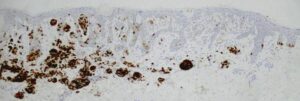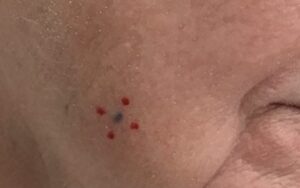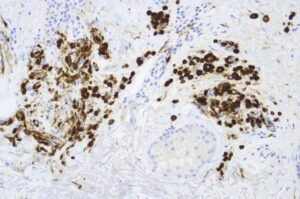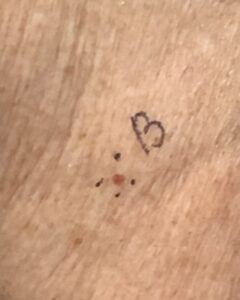Danielle M Auth2, Katie M Hodges2, Edward M Klepper1,2*, Maria L Andrzejewski1, Ahmed M Sikder1,2, Kishore E Clark1,2, Jonathan J Lee3, Howard N Robinson1,2
1Robinson and Max Dermatology PA, Lutherville-Timonium, Maryland, USA
2Bernstein and Robinson Dermatology PA, Belair, Maryland, USA
3Bethesda Dermatopathology Laboratory, Silver Spring, Maryland, USA
*Correspondence author: Edward M Klepper, MS, Robinson and Max Dermatology PA, Lutherville-Timonium, Maryland, USA and Bernstein and Robinson Dermatology PA, Belair, Maryland, USA; Email: [email protected]
Published Date: 31-12-2024
Copyright© 2024 by Auth DM, et al. All rights reserved. This is an open access article distributed under the terms of the Creative Commons Attribution License, which permits unrestricted use, distribution, and reproduction in any medium, provided the original author and source are credited.
Abstract
More recently, clinically-appearing atypical blue nevi which have been biopsied have been read by dermatopathologists as melanocytomas. We have noticed this phenomenon over the last 1-2 years. The spectrum between blue nevi, atypical blue nevi and melanocytomas seems to be blurry. With the advent of newer immunohistochemistry stains including, but not limited to, PRAME, Mel/Ki-67, p16 and BAP1; there have been more outright calls of melanocytomas. Below we describe three cases which, to us as clinicians, are an enigma. The proliferation of these immunostains – while it has helped in malignant differentiation – seems to also lead to confusing diagnoses.
Keywords: Melanoma; Melanocytoma; Immunostain; Melanocytic; Nevus; BAP1; PRAME; Mel/Ki-67; Immunohistochemistry; Blue Nevus
Introduction
Atypical melanocytic lesions overall are known to require a second opinion by many pathologists and some pathologists even disagree on definitive diagnosis due to their complexity and variability of histology. It seems that a melanocytoma is a rare melanocytic proliferation that is classified between an atypical nevus and melanoma with uncertain malignant potential [1]. Although systemic spread is rare (3.2%), these lesions have the capacity to metastasize to adjacent regional lymph nodes (41%) [2]. Since they do not metastasize far, it is thought that their prognosis is significantly more favorable than that of melanoma. Melanocytomas commonly arise de novo, but can also occur within a congenital nevus. They can appear as blue-black papules, plaques or nodules and are found mostly on the extremities. However, cases have also been reported on the back, scalp, genitals, shoulders, ankles, meninges of spinal cord and eyes including the choroid [2-4].
There are multiple differential diagnoses that melanocytomas may be mistaken for. These include, but are not limited to: blue nevus, deep penetrating nevus, combined nevus, cutaneous and pilar neurocristic hamartomas, melanoma arising in a blue nevus and more. Regardless, melanocytomas have also been found to be histologically identical and indistinguishable from epithelioid blue nevi [2].
Pigmented epithelial melanocytomas are composed of three cell types including dendritic cells, polygonal cells with dark pigmentation and epithelioid cells with abundant cytoplasm and large vesicular nuclei. Histologically, melanocytomas have sheets and nodules with heavily pigmented melanocytes in the deep dermis with an epithelioid and spindled appearance [2]. The epithelioid cells are seen more central and the spindle cells are closer to the periphery of the lesions. In addition, Fluorescence In-Situ Hybridization (FISH) can be used to aid in diagnosis. The two most common genetic alterations in melanocytomas are fusions in Protein Kinase C Alpha (PRKCA) and inactivating mutations in protein kinase cAMP-dependent type I regulatory subunit alpha (PRKAR1A), both of which are located in 17q24.2 [2].
According to the melanoma-or-not paradigm, it is recommended that all borderline lesions are treated as melanomas of equivalent thickness. However, this may not be the case for melanocytomas if they are in highly sensitive or cosmetic areas – in such a case, the provider may use clinical judgment to perform an excision with clear margins vs. a wide excision [1]. On the other hand, according to the current European recommendation, low-grade melanocytomas should have an excision with a 2-5 mm margin, while high-grade melanocytomas should have a 5-10 mm margin excision. They do not recommend follow-up for low-grade, but suggest a 6 month follow-up for 5 years for high-grade melanocytomas [5].
Melanocytomas are very rare, but very relevant. Health care providers need to be educated about these skin lesions in order to better educate and inform their patients and to appropriately treat them. Although disseminated spread is rare, these lesions need to be followed and appropriately excised to eliminate any potential for malignancy.
Case Report
Case 1
A 30-year-old female with a history of moderate dysplastic nevi of her left upper back and midline mid back presented for a full body skin examination. On examination, a 5 mm brown/pink macule was seen on the mid back at left of midline (Fig. 1). The macule had a smeared appearance on the lateral edge and irregular matrix on the superior portion under dermoscopy. A 6×6 mm shave biopsy was obtained which revealed an “Atypical Combined Compound Melanocytic Proliferation, Favor A Combined Compound Melanocytoma with clear margins. A description of the histology revealed a raised compound melanocytic neoplasm that is circumscribed by round nests at the dermo-epidermal junction. In between, junctional nests are variably fused and disordered and consist of epithelioid or spindled melanocytes with large nuclei that have irregular contours and cytoplasm that is dusky to ground glass. The melanocytes involve adnexal epithelia. Superficial dermal melanocytes consist of scattered nests and single conventional nevo-melanocytes along with nests of similar epithelioid forms seen at the dermo-epidermal junction. Immunohistochemical expression in the neoplastic melanocytes is p16 lost in the epithelioid and spindled forms and PRAME in rare junctional nests (appropriate controls included). There is a sparse lymphocytic inflammatory infiltrate” (Fig. 2,3). The melanocytoma was excised in the office. After excision, there was an addendum on the original path regarding a BAP1 immunostain which was predominantly retained but showed an altered and weak expression in a subset of melanocytes (Fig. 4). The patient was then referred for wider excision with a 1 cm margin.

Figure 1: On examination, a 5 mm brown/pink macule was seen on the mid back at left of midline.

Figure 2: 200x magnification of the entire lesion, highlighting the circumscription but two populations of cells: pale, larger epithelioid forms in the epidermis and papillary dermis and a deep dermal population of smaller melanocytes.

Figure 3: 200x magnification of p16 immunostain, showing large regions with preserved immunostain expression, but marked loss in superficial dermal, epithelioid forms (ovoid circle).

Figure 4: Representative section of BAP1 immunostaining showing preserved nuclear immunostain expression.
Case 2
An 80-year-old female with a history of sunburns presented for a full body skin examination. On examination, a 2 mm violaceous black papule was seen on her right lower cheek (Fig. 5). A 4 mm punch biopsy was obtained which revealed “Combined Melanocytoma (Intradermal Nevus and Focus Deep Penetrating Melanocytoma)” with the side margin involved. A description of the histology revealed “sparse aggregates of banal-appearing melanocytes are found within the dermis (Fig. 6). There is partial maturation with depth. A subset displays more epithelioid to avoid morphology with dusty gray cytoplasm and admixed melanophages. The melanocytes are PRAME-negative and show retained p16 (Fig. 7). Mel/Kl-67 shows a very rare uptick in nuclear reactivity within a dermal melanocyte (Fig. 8). The side margin is focally involved.” The melanocytoma was removed with an excision with 5 mm margins.

Figure 5: On examination, a 2 mm violaceous black papule was seen on her right lower cheek.

Figure 6: H&E 4x magnification revealed sparse aggregates of banal-appearing melanocytes within the dermis. There is partial maturation with depth. A subset displays more epithelioid to avoid morphology with dusty gray cytoplasm and admixed melanophages.

Figure 7: 20x magnification immunostain showed retained p16.

Figure 8: 20x magnification Mel-Ki67 immunostain showed a very rare uptick in nuclear reactivity within a dermal melanocyte.
Case 3
A 77-year-old female with a history of basal and squamous cell carcinomas presented for a full body skin examination. On examination, a 3 mm pink/gray papule was seen on her left upper arm (Fig. 9). A 4×3 mm shave biopsy was obtained which revealed “BAP-1-Inactivated Papular Melanocytoma with deep margin involved.” A description of the histology revealed “a somewhat dome-shaped growth with a proliferation of crowded intradermal melanocytes with irregular nest formation. Occasional admixed melanocytes have enlarged nuclei with open chromatin and prominent nucleoli. Mitotic figures were not detectable. A MITF (Microphthalmia Associated Transcription Factor) immunostain highlights the distribution of melanocytes, supporting the histologic interpretation. Mel/Ki-67 marks rare occasional dermal melanocytes. p16 appears retained. PRAME marks in patchy fashion a subset of the intradermal melanocytes. BAP-1 shows loss of nuclear staining within most of the lesional melanocytes. There is solar elastosis. The deep margin is involved.” The melanocytoma was excised in the office with a 5 mm margin excision.

Figure 9: On examination, a 3 mm pink/gray papule was seen on her left upper arm.
Discussion
It appears that in some cases, a melanocytoma may be benign or premalignant or actually malignant. The following markers discussed below were used to determine the diagnosis of these lesions as melanocytomas and differentiate them from benign nevi and a true malignant melanoma.
In case 1, the lesion’s histology in summary showed that 1) p16 was lost in the epithelioid, spindled forms, 2) PRAME was seen in rare junctional nests, 3) there was a sparse lymphocytic inflammatory infiltrate and 4) a BAP1 immunostain was predominantly retained but shows altered and weak expression in a subset.
In case 2, the lesion’s histology in summary showed 1) PRAME negative, 2) retained p16 and 3) a very rare uptick in Mel/Ki-67 nuclear reactivity within a dermal melanocyte.
In case 3, the lesion’s histology in summary showed 1) MITF immunostain highlights the distribution of melanocytes, 2) Mel/Ki-67 marks rare occasional dermal melanocytes, 3) retained p16, 4) PRAME marks in patchy fashion a subset of the intradermal melanocytes and 5) BAP-1 shows loss of nuclear staining within most of the lesional melanocytes.
To better understand what this means, we will further break down these markers. p16 is a tumor suppressor gene that is used in the Retinoblastoma (Rb) pathway and it encodes proteins that are involved in controlling this fundamental cell cycle pathway [6] . p16 does this by binding to cyclin-dependent kinases 4 and 6 to maintain the Rb gene in its active state. This gene then binds to the transcription factor E2F, which prevents the progression of the cell cycle. By inhibiting this cell cycle, it prevents the transformation of the cell into a tumor cell. Since p16 was lost in this melanocytic lesion, this shows that the pathway is not being inhibited, thus allowing cells to proliferate without control.
PRAME, which stands for “PReferentially Expressed Antigen in MElanoma”, is a repressor of the Retinoic Acid Receptor (RAR) signaling pathway. Retinoic acid is known to cease proliferation and differentiation, as well as initiating apoptosis. Defects in this pathway – especially with PRAME as it inhibits this pathway – have been shown to be implicated in cancer as this entails that RA production is suppressed [7]. In addition, PRAME has other names and should not be confused with the terms MAPE (Melanoma Antigen Preferentially Expressed in tumors) and/or OIP4 (Opa Interacting Protein 4). Most benign human tissue has minimal to no PRAME expression – however, it is interesting as there can be expression in the tissues of the ovary, placenta, adrenals, endometrium and most commonly the testis [8]. If PRAME is positive, this will inhibit the production of RA, thereby decreasing the inhibition of cell proliferation and differentiation and also inhibiting apoptosis. This has a double negative effect, which ultimately leads to increased cell proliferation and decreased controlled cell death.
BAP1, which stands for “BRCA1-Associated Protein-1”, is a tumor suppressor gene as it is thought to inhibit cell proliferation and promote apoptosis of impaired cells. The loss of BAP1 expression is associated with a poor prognosis and can help aid in diagnosis of a malignant lesion [9]. BAP1 is known to remove ubiquitin tags. Ubiquitin tags function normally by breaking down proteins. By BAP1 removing ubiquitin tags, it inhibits protein breakdown.
Mel/Ki-67 is a proliferative marker that is present during the G1, S, G2 and M stages of the cell cycle. When it shows increased expression in cells, it results in a boost of cell proliferation [10]. Mel/Ki-67 is a nuclear protein and it is able to aid in gene control by spatially organizing heterochromatin. It is also found that there is a strong correlation between its expression and an increased Breslow thickness, Clark’s level, invasion of lymphovascular tissue, ulceration, pT stage and the number of mitoses [11].
Conclusion
In the future, we anticipate that the markers which show the suppressor activity (or lack thereof) may be able to be enhanced through correction of the genetic mutations which could reduce chance of malignant transformation and metastasis. The definitive diagnosis of melanocytoma appears as a spectrum from premalignant to malignant and we recommend close communication with your dermatopathologists regarding the immunostaining to determine if they are closer to the malignant group which would require wider excisions.
Conflict of Interest
The authors declared no potential conflicts of interest with respect to the research, authorship and/or publication of this article.
Funding
This research received no specific grant from funding agencies in the public, commercial or not-for-profit sectors.
Acknowledgement
We would like to acknowledge David Terrano, M.D., Ph.D from Bethesda Dermatopathology Laboratory for the photomicrographs.
Author Contributions
All authors contributed equally on this final manuscript.
References
- Zembowicz A, Scolyer RA. Nevus/melanocytoma/melanoma: an emerging paradigm for classification of melanocytic neoplasms? Archives of Pathology and Laboratory Medicine. 2011;135(3):300-6.
- Bayraktar EC, Jour G. Pigmented epithelioid melanocytomas and their mimics; focus on their novel molecular findings. Biology. 2021;10(12):1290.
- Yang C, Fang J, Li G, Jia W, Liu H, Qi W, et al. Spinal meningeal melanocytomas: clinical manifestations, radiological and pathological characteristics and surgical outcomes. J Neuro-Oncol. 2016;127(2):279-86.
- Abdellaoui T, Belfaiza S, Malek Y, Essaoudi M, Elasri F, Reda K, et al. Large choroidal melanocytoma simulating choroidal melanoma: a difficult differential diagnosis and an inevitable enucleation. Case Reports in Ophthalmological Medicine. 2020;2020:8890857.
- Van den Broeke LR, Ebbelaar CF, Hayes DP, Bousema MT, Blokx WAM. Melanocytoma, an intermediate entity between nevus and melanoma: implications of the WHO classification of melanocytic skin tumours. Nederlands Tijdschrift Voor Geneeskunde. 2023;167:D7095.
- Rayess H, Wang MB, Srivatsan ES. Cellular senescence and tumor suppressor gene p16. Int J Cancer. 2011;130(8):1715-25.
- Epping MT, Wang L, Edel MJ, Carlée L, Hernandez M, Bernards R. The human tumor antigen PRAME is a dominant repressor of retinoic acid receptor signaling. Cell. 2005;122(6):835-47.
- Lezcano C, Jungbluth A, Busam K. PRAME. Pathology outlines. 2024 [Last accessed on: December 24, 2024]
https://www.pathologyoutlines.com/topic/stainsPRAME.html
- Stålhammar G. BAP1 pathology outlines. 2021 [Last accessed on: December 24, 2024]
https://www.pathologyoutlines.com/topic/stainsBAP1.html
- Moltajaei MH, Mehrbani SP, Motahari P, Rezapour R. Clinicopathological and prognostic value of Ki-67 expression in oral malignant melanoma: A systematic review and meta-analysis. J Dental Research, Dental Clinics, Dental Prospects. 2022;16(3):140-6.
- Liu Q, Peng Z, Shen L, Shen L. Prognostic and clinicopathological value of Ki-67 in melanoma: a meta-analysis. Front Oncol. 2021;11:737760.
Article Type
Case Report
Publication History
Received Date: 05-12-2024
Accepted Date: 23-12-2024
Published Date: 31-12-2024
Copyright© 2024 by Auth DM, et al. All rights reserved. This is an open access article distributed under the terms of the Creative Commons Attribution License, which permits unrestricted use, distribution, and reproduction in any medium, provided the original author and source are credited.
Citation: Auth DM, et al. Three Case Reports of Melanocytomas: A Melanoma to be or not to be? J Dermatol Res. 2024;5(3):1-8.

Figure 1: On examination, a 5 mm brown/pink macule was seen on the mid back at left of midline.

Figure 2: 200x magnification of the entire lesion, highlighting the circumscription but two populations of cells: pale, larger epithelioid forms in the epidermis and papillary dermis and a deep dermal population of smaller melanocytes.

Figure 3: 200x magnification of p16 immunostain, showing large regions with preserved immunostain expression, but marked loss in superficial dermal, epithelioid forms (ovoid circle).

Figure 4: Representative section of BAP1 immunostaining showing preserved nuclear immunostain expression.

Figure 5: On examination, a 2 mm violaceous black papule was seen on her right lower cheek.

Figure 6: H&E 4x magnification revealed sparse aggregates of banal-appearing melanocytes within the dermis. There is partial maturation with depth. A subset displays more epithelioid to avoid morphology with dusty gray cytoplasm and admixed melanophages.

Figure 7: 20x magnification immunostain showed retained p16.

Figure 8: 20x magnification Mel-Ki67 immunostain showed a very rare uptick in nuclear reactivity within a dermal melanocyte.

Figure 9: On examination, a 3 mm pink/gray papule was seen on her left upper arm.


